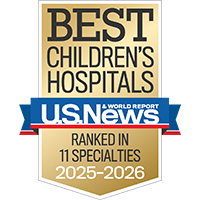Choanal atresia

Overview
Choanal atresia is a narrowing or blockage of the back of the nose that makes breathing difficult. The condition is congenital (present at birth), occurring when the soft tissues and bones that separate the nose, throat and mouth develop abnormally and obstruct the back opening of the nose. The cause is unknown. Although rare (affecting one in 7,000 births), choanal atresia is the most common nose abnormality in newborns. It's more common in girls than boys.
There are two forms of choanal atresia:
- Unilateral choanal atresia. One nasal passage is blocked. This is more common than bilateral. Babies with unilateral choanal atresia often have a chronic runny nose on the blocked side but otherwise may breathe well enough to go undiagnosed and untreated for years.
- Bilateral choanal atresia. Both nasal passages are blocked. Because infants mainly breathe through the nose (unless they're crying), a bilateral blockage makes it difficult to breathe. Affected newborns need a breathing tube until the condition can be surgically corrected.
Either form of the condition is commonly associated with other developmental abnormalities, such as a Tessier cleft, CHARGE syndrome or Treacher Collins syndrome. For this reason, a genetic evaluation is often recommended for infants or children diagnosed with choanal atresia.
Signs & symptoms
The symptoms of bilateral choanal atresia are evident at birth. Babies may need resuscitation at delivery or have a bluish tone to their skin because they're not getting enough oxygen. Other symptoms of either bilateral or unilateral choanal atresia include:
- Breathing difficulty that is relieved with crying
- Loud breathing
- Feeding difficulties
- Persistent nasal discharge
- Inability of the examining doctor to pass a suction tube through the baby's nose and into the throat
Diagnosis
Choanal atresia is diagnosed by examining the nasal passages. This usually involves passing an endoscope (a small flexible telescope) through the nose to look for a blockage. In addition, a CT scan can help doctors determine the exact location and severity of the blockage.
Treatment
Treatment depends on the severity of the condition.
Bilateral choanal atresia is a life-threatening emergency because when both nasal passages are blocked, a baby can't breathe. To help these babies immediately, a breathing tube is placed in the trachea (windpipe). Once the baby is stable, corrective endoscopic surgery can be done: Tiny instruments equipped with telescopes are inserted through the nose and mouth to remove the blockage and open the nasal passages. After surgery, there is a risk that developing scar tissue could block the nose again. A temporary stent may be placed to keep the nasal passage open while the infant heals from the surgery. Infants need to be examined regularly to ensure that they continue to have enough space in these openings to breathe.
Unilateral atresia doesn't typically require immediate treatment. If the baby isn't experiencing breathing or feeding problems, nothing more may be required beyond close observation and nose drops, though there is occasionally a need for supplemental oxygen. Surgery is easier in bigger kids, so parents can wait until their child is older before deciding whether to have the condition repaired.
Support services
Awards & recognition
-

Ranked among the nation's best in 11 specialties
































